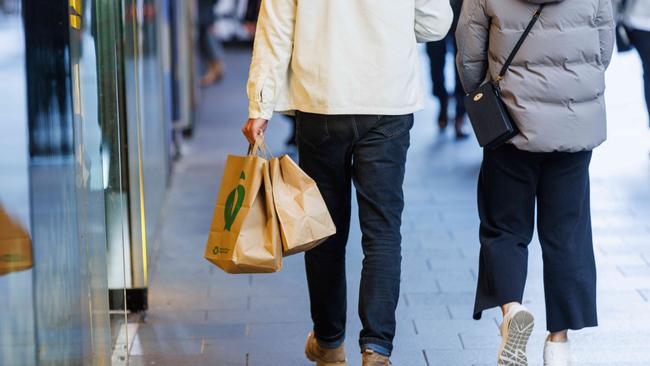Retail trade resilient in May as Australians spend on flowers, coffees and food
The much anticipated collapse in household spending amid an intense cost of living crunch has been pushed back to another day.

The much anticipated collapse in household spending has been pushed back to another day after new figures showed shoppers took advantage of discounts and ate out in droves to send retail trade firmly higher in May.
Despite an intense cost-of-living crunch and soaring borrowing costs and rents, data from the Australian Bureau of Statistics revealed a 0.7 per cent lift in trade to total $35.5bn in the month, well above analysts’ forecasts of a 0.1 per cent increase.
People were also prepared to keep spending in cafes and restaurants despite sharply higher prices, with trade climbing 1.4 per cent in the month to reach a record high 13 per cent higher than a year earlier, according to seasonally adjusted numbers.
With household budgets under pressure, analysts believe consumers are living on borrowed time and spending will weaken through the year.
The data comes despite major retailers - including David Jones - reporting a significant drop in sales this month,
NAB economist Taylor Nugent said “one month of data should not shift any assessment on the strength of the consumer too much, but today’s outcome suggests resilience”.
There was a hefty 2.2 per cent lift in “other retailing” in May – a broad category of discretionary goods including books, toys, cosmetics and sporting goods.
ABS head of retail statistics Ben Dorber said the latest increase in retail trade numbers reflected “larger than usual promotional activity and sales events for May”. An early start to end-of-financial-year discounting helped boost turnover, alongside Mother’s Day – the ABS reported that online flower sales were strong – and the “Click Frenzy Mayhem” sales event, he said.
“Just as we saw during the November Black Friday sales last year, consumers appeared to take extra advantage of discounting during large sales events in May in response to cost-of-living pressures,” Mr Dorber said.
The latest ABS figures showed there were enough Australians with money to keep the retail sector broadly ticking over for now, and also to suggest the Reserve Bank may need to keep hiking rates to cool demand – potentially as early as its next board meeting on Tuesday.
KPMG chief economist Brendan Rynne said it was clear in the data that Mother’s Day had provided a one-off boost to spending on flowers, chocolates and eating out. “Hopefully (RBA) governor (Philip) Lowe won’t be punishing us for taking our mums out to lunch,” Dr Rynne said.
Major retailers are reporting customers have put an end to the free-spending period that accompanied a reopening economy, with Harvey Norman forecasting sales in this financial year would be a third lower than in 2022.
With prices still climbing briskly, the growth in retail trade – which accounts for about one-third of total household consumption – suggested people were spending but not necessarily buying much more.
National accounts figures released earlier this month showed real – or after-inflation – consumption slowed to just 0.2 per cent in the three months to March, and UBS chief economist George Tharenou said he expected an even weaker increase in the June quarter.
“The consumer – for now – is still weakening, but not collapsing,” Mr Tharenou said.
After figures on Wednesday showed inflation plunged in the year to May to a still-high 5.6 per cent, Jim Chalmers on Thursday said he recognised that Australians were “doing it tough” and spruiked Labor’s increase to childcare subsidies starting next week.
After revealing this week that the projected $4.2bn budget surplus this financial year would come in “significantly” larger, the Treasurer ruled out further cost-of-living relief for now, saying “I’m not contemplating more support or floating more support”.
The latest evidence of ongoing economic resilience comes as separate ABS data showed the number of job vacancies dropped by 9000, or 2 per cent, in the three months to May, extending a year-long decline of 10 per cent.
At 432,000, there were still approaching twice as many job vacancies as before the pandemic.
The share of employers reporting at least one vacancy increased slightly to 25 per cent, more than double the 11 per cent of businesses advertising for workers in February 2020 and before the Covid health crisis.
ANZ economist Madeline Dunk said demand for labour remained “fierce”.
Ms Dunk said the latest updates on retail sales and the labour market outweighed this week’s soft inflation read, and supported a rate rise to 4.35 per cent on Tuesday.




To join the conversation, please log in. Don't have an account? Register
Join the conversation, you are commenting as Logout